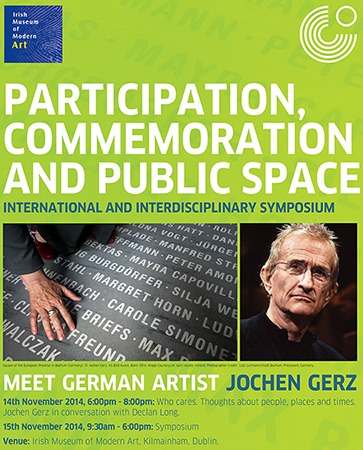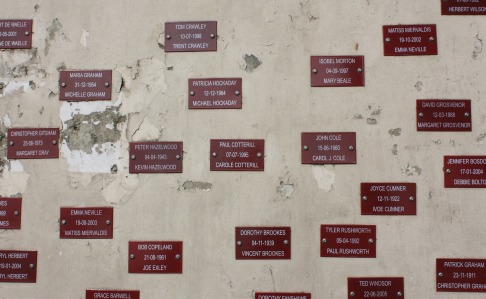All entries for Tuesday 25 November 2014
November 25, 2014
International Symposium on Jochen Gerz

Last weekend I was speaking at this symposium in Dublin, organised by the Goethe Institut at the Irish Museum of Modern Art. All the speakers were invited, being those whom in the last twenty years have published major pieces of research on Gerz’s work: Söke Dinkla, Marion Hohlfeldt, Guido Meincke, Renate Petzinger, Philippe Mesnard, and myself. It also featured those central to Dublin’s cultural scene, Declan McGonagle, Jenny Haughton, Pat Cooke, Lisa Moran, and Ray Yeates, among others. Jochen himself gave the opening address the night before, to a small but packed audience including the German ambassador. My paper was called ‘Countermonument and the materiality of memory: Jochen Gerz and Coventry’s Future Monument and Public Bench’. I was asked to concentrate on Coventry given my involvement with Jochen during his four years working on the city regeneration, branded by the city as the ‘Phoenix Initiative’.
Jochen Gerz’s now famous concept of ‘Public Authorship’ was engineered in Coventry around the millennium year 2000 – which we all remember as the year of the huge wave of public commissions by the UK government as part of the Millennium celebrations. The central component of the regeneration was a new ‘Place’, or plaza, which was to act as the missing public gathering place for the city. The masterplan was actually well-thought out by a prestigious and well-meaning design team, intent on creating new space for ‘the public’. The entire area was structured as a metaphorical journey (the physical trajectory being an actual pedestrian route) through Coventry’s historic centre, animated by the theme of reconciliation between the past, its industry and national self-assertion, and the present and its aspirations for renewed productivity and for international peace. Physically this would run from the old bombed-out cathedral from World War Two and earlier archaeological ruins, through a new boulevard into the new plaza (onto which a new frontage of the famous transportation museum opened), around a new spiral ramp and up to a parkland area: The Garden of International Friendship. This would, ostensibly, provide an ethically charged journey from past to future – and a prelude to the re-branding and marketing of Coventry city centre as a place for public culture. The reality, of course, is that (particularly after September 11th 2001) the idea of a Garden of International Friendship was not so compelling, and today the area seems odd and somehow has not fulfilled its purpose.
The Future Monument is a 4.6m high obelisk made of a glass compound – around which, to the north, are names of associations or groups of citizens; on the south side are plaques engraved with the names of former enemies who are now, or will be, friends. The surface of The Monument appears shattered (is shattered glass sealed with a thick compound surface – a premiditated response to expected vandalism), and is lit up internally at night. Its apearance has been inflected by plantlife growing within it – quite hilarious, but something that has inadvertendly maintained its interest. The Public Bench features over 2000 plaques bearing the names of Coventry residents, and the names of anyone, anywhere in the world who remain significant in the memory of a Coventry resident. The Bench runs along the north rim of the square, made of concrete and wood, 45m long. Physically the two works are close but not contiguous.
‘Public Authorship’ as a title for a project – was open-ended and indeterminate in meaning; Jochen’s emphasis was on dialogue and city-wide deliberation on the meaning of ‘public’ and the role of monuments in the city (the being a countermonument, or what he called ‘antimonument’, project). The ‘Public’ in Public Authorship’ was not synonymous with the social…. It was not a form of art populism: It demanded participation, through writing, literacy, cooperation, and individual acts of self-representation. What does it mean for the public to ‘author’ – in the city? And what did it mean, to ‘author’ a monument? However, the genius of the term was that it seemed quite transparent, direct and beckoned a lot of public and media attention as it first appeared in various opening events and meetings in Coventry. When Jochen arrived in Coventry in 1999 there was no site for an art work, and he had no detailed plans, only two line-drawings and two questions -- ‘Who are the enemies of the past?’ And, ‘Who are your modern friends?’ The questions he asked the Coventry ‘public’ for three years before inscribing names of some of his interlocutors on plaques. The dialogue over that time hit at the heart of issues to do with the socio-political conditions of Europe, nationalism, multiculturalism – and during and after September 11 all talk of ‘our enemies’ was regarded by some city councillors are inflammatory. Yet it continued and Jochen successfully engaged with (and uncovered) a lot of the complexity of Coventry’s population, to some degree deflating the myth of a ‘general’ public. Go see it.

 Jonathan Vickery
Jonathan Vickery

 Please wait - comments are loading
Please wait - comments are loading

 Loading…
Loading…